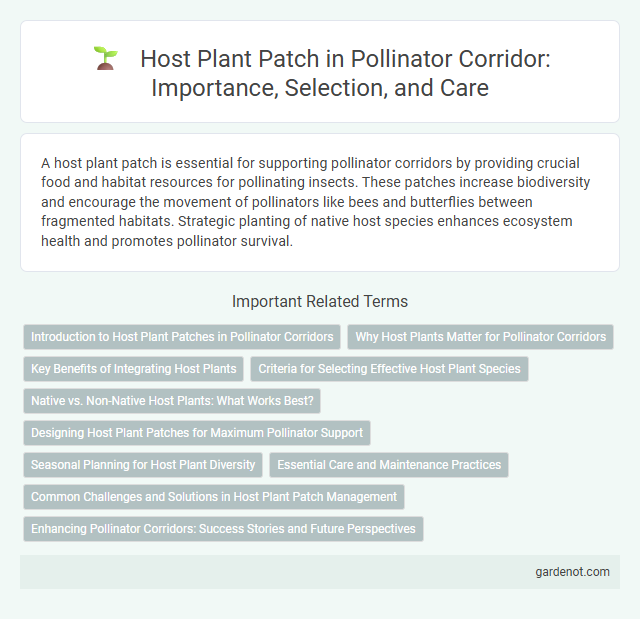A host plant patch is essential for supporting pollinator corridors by providing crucial food and habitat resources for pollinating insects. These patches increase biodiversity and encourage the movement of pollinators like bees and butterflies between fragmented habitats. Strategic planting of native host species enhances ecosystem health and promotes pollinator survival.
Introduction to Host Plant Patches in Pollinator Corridors
Host plant patches are essential components of pollinator corridors, providing critical food sources and habitat for diverse pollinator species such as bees, butterflies, and hummingbirds. These patches consist of native flowering plants that support various life stages of pollinators, from larval development to adult foraging. Integrating host plant patches into landscape planning enhances pollinator health, biodiversity, and ecological connectivity by facilitating movement across fragmented habitats.
Why Host Plants Matter for Pollinator Corridors
Host plants provide essential nectar and pollen resources that sustain pollinator populations within corridors, ensuring their survival and reproduction. These plants create vital habitat patches that support diverse pollinator species by offering continuous foraging opportunities throughout their life cycles. Incorporating native host plants enhances ecological connectivity, promoting genetic diversity and resilience in pollinator communities across fragmented landscapes.
Key Benefits of Integrating Host Plants
Integrating host plants in pollinator corridors significantly enhances habitat quality by providing essential resources for the complete life cycle of pollinators, especially butterflies and moths. These patches increase biodiversity and support local ecosystems by offering food, shelter, and breeding sites, promoting pollinator health and population stability. Research shows that host plant diversity directly correlates with higher pollinator abundance and resilience against environmental stressors.
Criteria for Selecting Effective Host Plant Species
Effective host plant species for pollinator corridors must provide abundant nectar and pollen resources across the entire flight season of local pollinator communities. Selection criteria prioritize native plants with high floral diversity, structural complexity, and adaptability to local soil and climate conditions to maximize pollinator attraction and habitat stability. Including species that support the full life cycle of target pollinators, such as larval food sources and shelter, enhances corridor functionality and promotes biodiversity conservation.
Native vs. Non-Native Host Plants: What Works Best?
Native host plants support local pollinator species by providing essential nectar, pollen, and habitat, resulting in higher pollinator diversity and abundance compared to non-native plants. Non-native host plants often lack the specific nutritional profiles or flowering times that native pollinators depend on, reducing their effectiveness in sustaining pollinator populations. Ensuring a predominance of native host plant patches in pollinator corridors maximizes ecosystem resilience and promotes long-term pollinator health.
Designing Host Plant Patches for Maximum Pollinator Support
Designing host plant patches involves selecting native plant species that provide essential resources such as nectar, pollen, and larval food to a wide range of pollinators including bees, butterflies, and moths. Spatial arrangement should maximize floral diversity and bloom succession to ensure continuous forage throughout the growing season, while patch size and connectivity facilitate pollinator movement and population stability. Incorporating plants with varying flower shapes, colors, and bloom times enhances attractiveness and supports specialized pollinators, thereby strengthening the overall resilience of pollinator corridors.
Seasonal Planning for Host Plant Diversity
Seasonal planning for host plant diversity in pollinator corridors ensures a continuous supply of nectar and pollen throughout the year, supporting various pollinator species. Incorporating early-blooming, mid-season, and late-flowering plants maximizes habitat suitability and promotes diverse insect populations. This strategic scheduling enhances ecosystem resilience and sustains pollinator health by providing staggered resources aligned with seasonal pollinator activity.
Essential Care and Maintenance Practices
Host plant patches within pollinator corridors require regular watering, especially during dry periods, to maintain healthy growth and flowering essential for pollinator sustenance. Removing invasive species and dead plant material ensures that native host plants thrive without competition, promoting a balanced ecosystem. Periodic soil testing and appropriate organic fertilization enhance nutrient availability, supporting robust plant development and increased pollinator visits.
Common Challenges and Solutions in Host Plant Patch Management
Host plant patch management faces common challenges such as habitat fragmentation, invasive species encroachment, and inconsistent plant availability, which can disrupt pollinator foraging patterns. Implementing native plant restoration, controlling invasive species through targeted removal, and ensuring temporal plant diversity are effective solutions to maintain ecological balance and support pollinator health. Monitoring plant phenology and soil conditions also enhances the resilience and sustainability of host plant patches within pollinator corridors.
Enhancing Pollinator Corridors: Success Stories and Future Perspectives
Host plant patches play a critical role in enhancing pollinator corridors by providing essential resources such as nectar, pollen, and habitat connectivity, which support diverse pollinator species. Successful restoration projects have demonstrated increased pollinator abundance and diversity where native host plants are strategically planted along corridor pathways. Future perspectives emphasize the integration of native plant patches with urban planning and climate resilience strategies to sustain pollinator populations and ecosystem services.
Host plant patch Infographic

 gardenot.com
gardenot.com